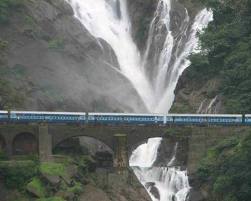 Mysore Palace
Mysore PalaceThe Palace of Mysore (also known as the Amba Vilas Palace) is a historical palace in the city of Mysore in Karnataka, southern India. It is the official residence and seat of the Wodeyars — the Maharajas of Mysore, the former royal family of Mysore, who ruled the princely state of Mysore from 1399 to 1950.The palace is in the central region of inner Mysore, facing the Chamundi Hills eastward.
Mysore is commonly described as the City of Palaces. There are about seven palaces inclusive of this; however, Mysore Palace refers specifically to the one within the Old Fort. Built by the Maharaja Rajarshi H.H. Krishnarajendra Wadiyar IV, Mysore Palace is now one of the most famous tourist attractions in India, after the Taj Mahal, and has more than 4 million visitors annually.
The original palace built of wood, got burnt down in 1897, during the wedding of Jayalakshammanni, the eldest daughter of Chamaraja Wodeyar and was rebuilt in 1912 at the cost of Rs. 42 lakhs. The present Palace built in Indo-Saracenic style and blends together Hindu, Muslim, Rajput, and Gothic styles of architecture. It is a three-storied stone structure, with marble domes and a 145 ft five-storied tower. Above the central arch is an impressive sculpture of Gajalakshmi, the goddess of wealth, prosperity, good luck, and abundance with her elephants. The palace is surrounded by a large garden. Designed by the well-known British architect, Henry Irwin, the palace is a treasure house of exquisite carvings and works of art from all over the world.
 The Maharaja's Palace is a beautiful three storied stone
building of fine gray granite and rich pink marble domes, overlooking
this structure is a five-storied 145 foot tower whose domes are gilded
in gold. One enters the Palace through the Gombe Thotti or the Doll's
Pavilion; this is a pavilion of traditional dolls from the nineteenth
and early twentieth centuries. This collection also has a wooden
elephant howdah (structure for carrying people on the elephant) that is
decorated with 84 kilograms of gold.
The Maharaja's Palace is a beautiful three storied stone
building of fine gray granite and rich pink marble domes, overlooking
this structure is a five-storied 145 foot tower whose domes are gilded
in gold. One enters the Palace through the Gombe Thotti or the Doll's
Pavilion; this is a pavilion of traditional dolls from the nineteenth
and early twentieth centuries. This collection also has a wooden
elephant howdah (structure for carrying people on the elephant) that is
decorated with 84 kilograms of gold. Special events
Mysore palace in the evening
Every autumn, the palace is the venue for the famous Mysore Dasara festival, during which leading artists perform on a stage set up in the palace grounds. On the tenth day of the festival Vijaya Dashami, a parade with caparisoned elephants and floats originate from the palace grounds.
Dasara is the most extravagant festival of Mysore. It is celebrated in September and October of each year. The festival celebrates and commemorates the victory of the great Goddess Durga, also called
This festival has been celebrated by the Wodeyars at Srirangapatna since 1610, and in Mysore with great pomp since 1799. The tradition is still carried on, although the scale of the celebrations has diminished. The Dasara festivities have become an integral part of the culture and life in Mysore. To celebrate this festival, the Palace of Mysore is illuminated with more than 96,000 lights during the two-month period.
Chamundeshwari, after she slew the demon Mahishasura, thereby symbolizing the triumph of good over evil according to Hindu mythology.
During the Dasara the Royal throne made of 200kgs of pure gold is displayed. It is claimed that the ancestry of the throne can be traced to the Pandavas.
ATTARACTIONS NEARBY MYSORE PALACE:
Prasanna Krishnaswamy Temple
Lakshmiramana Swamy Temple
Mysore Palace Timings:
10.00 am - 05.30 pm
Mysore Palace is open all days of the week
Mysore Palace Entry Charges:
Adults Rs. 40/-
Children between 10 - 18 Years : Rs. 20/-
Children below 10 years : Free Entrance
Foreign Tourist Rs. 200/- (Audio Kit Facility Included)
Tickets are sold at southern gate of the Mysore Palace.
Mysore Palace Illumination Timings:
07.00 pm - 07.45 pm on Sundays, National Holidays and State Festivals.
07.40 pm - 07.45 pm on weekdays (Monday to Saturday) after the sound and light show.
There is no charges to watch Mysore Palace lighting
Mysore Palace Sound and Light Show:
07.00 pm - 07.40 pm
On weekdays (Monday to Saturday) except Sundays, National Holidays and State Festivals.
Sound and Light Show Entry Charges:
Adults Rs. 40/-
Children between 7 - 12 years : Rs. 25/-
Foreign Tourist Rs. 200/-
Tickets are sold at southern gate of the Mysore Palace.
How to Reach Mysore Palace
By Road
Mysore is 139kms to the south west of Bangalore. The state highway that connects these two cities is very well maintained. Travelling from Bangalore to Mysore by road is a pleasant experience and will take about 3hrs. There are ordinary buses, semi-luxury buses and luxury buses operated by the Government of Karnataka. Every half an hour there is a non-stop bus to Mysore from Bangalore Bus Station.
By Train
Mysore is connected with a number of trains to Bangalore. The super fast luxury train the Shatabdi Express connects Mysore to Madras. The quickest and most comfortable way to reach Mysore is via Bangalore.
By Air
The nearest airport to Mysore is Bangalore (139 km). All the domestic airlines in the country operate their flights to Bangalore from all the major cities in the country. Some international airlines too have flights to Bangalore. Bangalore is to have an international airport shortly.
























